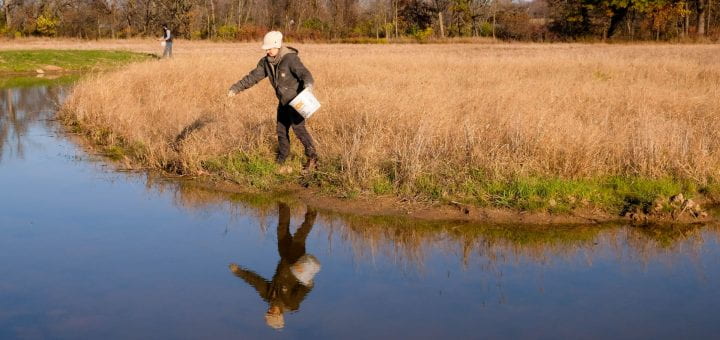
UW-Green Bay’s Natural Areas Ecologist, Bobbie Webster plants wet meadow plant seeds at the Wequiock Creek Natural Area. UW-Green Bay, Sue Pischke University Photographer
Staff from the Cofrin Center of Biodiversity, community volunteers, and UW-Green Bay students from Professor Amy Wolf’s Conservation Biology plant seeds at the Wequiock Creek Natural Area. The restoration being conducted here will provide crucial habitat for pollinators, birds, bats and other wildlife. The work will improve the Wequiock Creek watershed by reducing nutrient and sediment loading to Green Bay. Finally, this work is being coordinated with First Nations representatives and archaeologists to ensure the project will honor and educate people about the cultural significance of this land to First Nations people.
Click to advance slideshow or view the album on Flickr. (Photos by Sue Pischke, Bob Howe, Dan Meinhardt, and Amy Wolf.)
The project, led by staff of the UW-Green Bay Cofrin Center for Biodiversity, in collaboration with faculty members Amy Wolf and Karen Stahlheber and many partners, is an ambitious ecological restoration project at the newly created Wequiock Creek Natural Area in the Town of Scott in Brown County. The Wequiock Creek Natural Area is owned by the Northeast Wisconsin Land Trust and the Town of Scott, and adjoins UW’Green Bay’s Point au Sable Natural Area, creating a 250+ acre “green corridor” for conservation and water quality protection.
Last week, a custom prairie mix was installed by no-till drill on two agricultural fields totaling 30 acres formerly farmed for winter wheat and soybeans. On Thursday, Nov. 4, 2021, UW-Green Bay students in Wolf’s Conservation Biology hand-sowed the same prairie mix in a 4.5-acre field that has been plowed and prepared by the local farmer who formerly rented this agricultural land. Community volunteers also hand-sowed wet meadow species on several restored wetlands that will be imbedded in the prairie/oak savanna.
The prairie installation will be accompanied by planting of oak and hickory saplings in the next few years with the ultimate goal of restoring this area to oak savanna. Oak savanna is a globally imperiled natural community and in Wisconsin, often is accompanied by “millenia of indigenous stewardship.” (Raniawrites.com)
Funding for this work comes from the US Fish and Wildlife Service Coastal Program, The Fox River Trustee Council (Natural Resource Damage Assessment), WI Coastal Management Program, WI DNR Knowles Nelson Stewardship program, The 1923 Fund, and the National Fish and Wildlife Foundation.
- Total project area: 76 (75.75) acres
- South Field: 13 acres (~0.4 acres wetland)
- North Field: 18 acres (~ 1.3 acres wetland)
- East Field: 5 acres
- Riparian forest: 21 acres
- Upland forest/other: 5 acres
- Seed mixes (Prairie Moon Nursery)
- Mesic prairie: 33 species (5 grasses, 1 sedge)
- Wet meadow (29 species (6 grasses, 4 sedges)
- Current landowners: Northeast Wisconsin Land Trust / Town of Scott
Text by Robert Howe, photos submitted.
